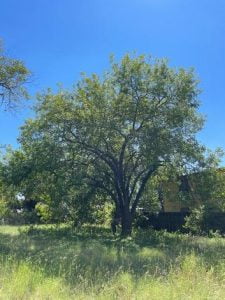To Treat or Not to Treat – Holistic Plant Health Care
Written by Joshua Morales, Assistant Project ManagerOur team at Tree Mann Solutions wishes our clients, colleagues, and friends a Happy Spring! In this upcoming season, we want to educate our partners to be stewards of healthy trees across Texas. Spring is a time of new beginnings, not just for leaves and seedlings, but also for pests like insects, fungi, and bacteria.
We want to share a few tips and tricks that can help your trees succeed, whether you own/manage a newly planted live oak seedling or an old, mature pecan. Wholistic suggestions that any homeowner/manager can do, without any chemical applications.
 To Treat
To Treat
Trees, shrubs, and plants are living beings that are in constant flux, competing for nutrients, water, and space. The goal of Plant Health Care (PHC) programs is to help maintain or improve the landscape’s appearance, vitality, and safety using the most cost-effective and environmentally sensitive practices and treatments available (trees are good.com). However, many times PHC usually just means spraying/applying products to eliminate the symptoms a tree is exhibiting. Applications have their place in our urban environment. At times, a pesticide application is the only way to provide care for a tree. A deadly example threatening us in the Central Texas region is the emerald ash borer and our native ash trees (green ash, Texas ash, etc.). A perfectly healthy ash tree can decline and die overnight if not pre-treated for an emerald ash borer infestation.
 To Not Treat
To Not Treat
Most tree-related health issues can be addressed and improved with simple techniques that are cost efficient and effective. It all starts with planting native, hardy trees that are acclimated to our climate and our conditions. If planting on a dry site where irrigation is limited, a native cedar elm will do much better than a water thirsty bald cypress. Proper site planning can yield benefits for generations to come. As our environment is always in flux, nutrients are being transformed from one state to another. Fertilization is a favorite of both applicators and tree managers. A more sustainable, cost-effective way to feed trees is right before our eyes. Rather than bagging up the leaves that a tree drops, one can grind them up and leave them in the yard for them to cycle back into their local environment. The most common issue prevalent in urban landscapes is overwatering. Trees can sometimes be so overwatered that they “drown”. These “drowning” symptoms are then treated, but the root cause remains. When the most effective treatment is to simply reduce the timer on the irrigation system. At TMS, we strive to view plant health care as an important part of our toolbelt that we only reach for in certain cases. Wholistic techniques to plant health care can often yield healthier trees and healthier people.
Please reach out to our team if you have any questions! We appreciate our clients, colleagues, and friends and want to be a resource for healthy trees across Texas!
 To Treat
To Treat To Not Treat
To Not Treat